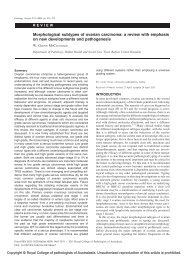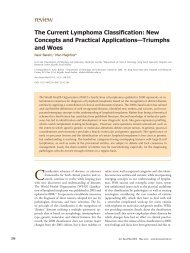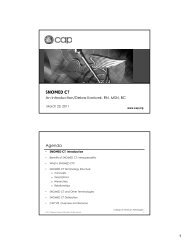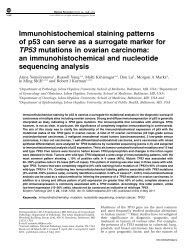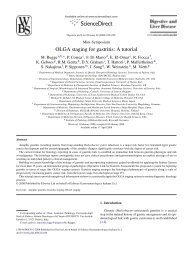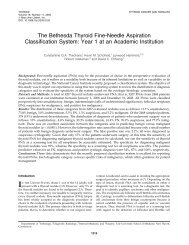Squamous cell and adenosquamous carcinomas of ... - BPA Pathology
Squamous cell and adenosquamous carcinomas of ... - BPA Pathology
Squamous cell and adenosquamous carcinomas of ... - BPA Pathology
Create successful ePaper yourself
Turn your PDF publications into a flip-book with our unique Google optimized e-Paper software.
Modern <strong>Pathology</strong> (2011) 24, 1069–1078<br />
& 2011 USCAP, Inc. All rights reserved 0893-3952/11 $32.00 1069<br />
<strong>Squamous</strong> <strong>cell</strong> <strong>and</strong> <strong>adenosquamous</strong><br />
<strong>carcinomas</strong> <strong>of</strong> the gallbladder:<br />
clinicopathological analysis <strong>of</strong> 34 cases<br />
identified in 606 <strong>carcinomas</strong><br />
Juan C Roa 1 , Oscar Tapia 1 , Asli Cakir 2 , Olca Basturk 3 , Nevra Dursun 4 , Deniz Akdemir 5 ,<br />
Burcu Saka 6 , Hector Losada 7 , Pelin Bagci 8 <strong>and</strong> N Volkan Adsay 8<br />
1<br />
Department <strong>of</strong> <strong>Pathology</strong>, Universidad de La Frontera, Temuco, Chile; 2 Department <strong>of</strong> <strong>Pathology</strong>, Çorlu State<br />
Hospital, Çorlu, Turkey; 3 Department <strong>of</strong> <strong>Pathology</strong>, Memorial Sloan-Kettering Cancer Center, New York, NY,<br />
USA; 4 Department <strong>of</strong> <strong>Pathology</strong>, Istanbul Education <strong>and</strong> Research Hospital, Istanbul, Turkey; 5 Department <strong>of</strong><br />
Biostatistics, Ohio Northern University, Ada, OH, USA; 6 Department <strong>of</strong> <strong>Pathology</strong>, Gazi University, Ankara,<br />
Turkey; 7 Department <strong>of</strong> Surgery, Universidad de La Frontera, Temuco, Chile <strong>and</strong> 8 Department <strong>of</strong> <strong>Pathology</strong>,<br />
Emory University Hospital, Atlanta, GA, USA<br />
The information in the literature on squamous <strong>cell</strong> <strong>and</strong> <strong>adenosquamous</strong> <strong>carcinomas</strong> <strong>of</strong> the gallbladder is highly<br />
limited. In this study, 606 resected invasive gallbladder carcinoma cases were analyzed. <strong>Squamous</strong><br />
differentiation was identified in 41 cases (7%). Those without any identifiable gl<strong>and</strong>ular-type invasive<br />
component were classified as pure squamous <strong>cell</strong> <strong>carcinomas</strong> (8 cases) <strong>and</strong> those with the squamous<br />
component constituting 25–99% <strong>of</strong> the tumors were classified as <strong>adenosquamous</strong> <strong>carcinomas</strong> (26 cases) <strong>and</strong><br />
included into the analysis. The remaining 7 that had o25% squamous component were classified as<br />
adenocarcinoma with focal squamous change <strong>and</strong> excluded. The clinicopathological characteristics <strong>of</strong><br />
<strong>adenosquamous</strong> carcinoma/squamous <strong>cell</strong> <strong>carcinomas</strong> were documented <strong>and</strong> contrasted with that <strong>of</strong> ordinary<br />
gallbladder adeno<strong>carcinomas</strong>. The average patient age was 65 years (range 26–81); female/male ratio, 3.8. In<br />
only 13%, there was a preoperative clinical suspicion <strong>of</strong> malignancy. Grossly, 58% presented as thickening <strong>and</strong><br />
hardening <strong>of</strong> the wall <strong>and</strong> 6% were polypoid. In 12%, mucosa adjacent to the tumor revealed squamous<br />
metaplasia. All pure squamous <strong>cell</strong> <strong>carcinomas</strong> had prominent keratinization. Giant <strong>cell</strong>s <strong>and</strong> tumor-infiltrating<br />
eosinophils were observed in 29 <strong>and</strong> 51% <strong>of</strong> the squamous <strong>cell</strong> <strong>carcinomas</strong>/<strong>adenosquamous</strong> <strong>carcinomas</strong><br />
versus 10% (P ¼ 0.02) <strong>and</strong> 6% (P ¼ 0.001) in gallbladder adeno<strong>carcinomas</strong>, respectively. All but three cases had<br />
‘advanced’ (pT2 <strong>and</strong> above) <strong>carcinomas</strong>. Follow-up was available in 31 patients: 25 died <strong>of</strong> disease (median ¼ 5<br />
months, range 0–20), <strong>and</strong> 6 were alive (median ¼ 64 months, range 5–112.5). The survival <strong>of</strong> patients with<br />
squamous <strong>cell</strong> <strong>carcinomas</strong>/<strong>adenosquamous</strong> <strong>carcinomas</strong> was significantly worse than that <strong>of</strong> gallbladder<br />
adeno<strong>carcinomas</strong> (P ¼ 0.003), <strong>and</strong> this adverse prognosis persisted when compared with stage-matched<br />
advanced gallbladder adenocarcinoma cases (median ¼ 11.4 months, P ¼ 0.01). In conclusion, squamous<br />
differentiation was noted in 7% <strong>of</strong> gallbladder <strong>carcinomas</strong>. The incidence <strong>of</strong> <strong>adenosquamous</strong> carcinoma<br />
(defined as 25–99% <strong>of</strong> the tumor being squamous) was 4%, <strong>and</strong> that <strong>of</strong> pure squamous <strong>cell</strong> carcinoma (without<br />
any documented invasive gl<strong>and</strong>ular component) was 1%. Pure squamous <strong>cell</strong> <strong>carcinomas</strong> <strong>of</strong>ten showed<br />
prominent keratinization. The overall prognosis <strong>of</strong> <strong>adenosquamous</strong> carcinoma/squamous <strong>cell</strong> carcinoma<br />
appears to be even worse than that <strong>of</strong> ordinary adeno<strong>carcinomas</strong>. Most patients died within a few months;<br />
however, those few who were alive beyond 2 years in this cohort experienced long-term survival.<br />
Modern <strong>Pathology</strong> (2011) 24, 1069–1078; doi:10.1038/modpathol.2011.68; published online 29 April 2011<br />
Keywords: <strong>adenosquamous</strong>; carcinoma; gallbladder; squamous<br />
Correspondence: Pr<strong>of</strong>essor NV Adsay, MD, Department <strong>of</strong> <strong>Pathology</strong> <strong>and</strong> Laboratory Medicine, Emory University Hospital, 1364 Clifton<br />
Road NE, Room H-180B, Atlanta, GA 30322, USA.<br />
E-mail: volkan.adsay@emory.edu<br />
This study was presented in part at the annual meeting <strong>of</strong> the United States <strong>and</strong> Canadian Academy <strong>of</strong> <strong>Pathology</strong> in Washington, DC, in 2010.<br />
Received 27 October 2010; revised 2 March 2011; accepted 2 March 2011; published online 29 April 2011<br />
www.modernpathology.org
<strong>Squamous</strong> <strong>cell</strong> <strong>carcinomas</strong> <strong>of</strong> the gallbladder<br />
1070 JC Roa et al<br />
Gallbladder cancer is the most frequent neoplasm <strong>of</strong><br />
the biliary tract with a clear predominance in the<br />
female population (2–6 times more frequent than in<br />
men). 1–4 Its prevalence is widely variable, depending<br />
on the population studied: for example, in the<br />
United States, its frequency is 1.43/100 000 inhabitants,<br />
whereas in countries like Chile, this figure<br />
climbs up to 17.8/100 000 inhabitants. 3,5,6 At the<br />
same time, variations in its prevalence have been<br />
reported for both different indigenous groups <strong>and</strong><br />
different geographical areas in the same country;<br />
facts that suggest important genetic <strong>and</strong> environmental<br />
influences on the development <strong>of</strong> the<br />
disease.<br />
Adeno<strong>carcinomas</strong> are by far the most frequent<br />
histological subtype <strong>of</strong> the malignant gallbladder<br />
neoplasms, representing approximately 90–95% <strong>of</strong><br />
all cases. 1 In contrast, squamous <strong>cell</strong> or ‘epidermoid’<br />
<strong>carcinomas</strong> <strong>and</strong> <strong>adenosquamous</strong> <strong>carcinomas</strong> are<br />
rare. 1,7,8 The literature on these histologic types has<br />
been highly limited, mostly represented as individual<br />
case reports or analysis <strong>of</strong> small case series <strong>of</strong> a<br />
h<strong>and</strong>ful <strong>of</strong> cases. 9–20 Furthermore, there has been no<br />
uniform definition for these tumors, with different<br />
authors employing different criteria: some regarded<br />
any squamous differentiation as a qualification for<br />
<strong>adenosquamous</strong> carcinoma even if it is a very small<br />
component <strong>of</strong> the tumor, <strong>and</strong> at the same time,<br />
others seemed to have included cases with substantial<br />
adenocarcinoma component into squamous<br />
<strong>cell</strong> carcinoma category. 9,13,14,21–23 These definitional<br />
differences may partly be responsible for the variations<br />
in reported incidence <strong>of</strong> these tumors, which<br />
ranges from 1 to 12%. 14,18,24–28 Although the limited<br />
nature <strong>of</strong> the data <strong>and</strong> the definitional variations<br />
precluded proper characterization <strong>of</strong> these tumors,<br />
some common threads could be observed: it had<br />
been speculated that <strong>adenosquamous</strong> <strong>carcinomas</strong>/<br />
squamous <strong>cell</strong> <strong>carcinomas</strong> are at least as aggressive<br />
as ordinary gallbladder adeno<strong>carcinomas</strong>. 9,11,13–15,23,29<br />
It has been observed that the squamous component<br />
<strong>of</strong> gallbladder <strong>carcinomas</strong> proliferates at a higher<br />
rate than the gl<strong>and</strong>ular component; 14 however,<br />
despite their high proliferation rate, these tumors<br />
appeared to less frequently present with lymph<br />
node metastasis than gallbladder adeno<strong>carcinomas</strong>.<br />
21 Their aggressive biological behavior has been<br />
attributed to their potential for direct extension<br />
<strong>and</strong> early invasion into the liver <strong>and</strong> neighboring<br />
organs, such as the stomach, duodenum <strong>and</strong><br />
transverse colon. 9,21,23,29,30<br />
The biology <strong>of</strong> <strong>carcinomas</strong> with squamous differentiation<br />
is intriguing. When all organs <strong>and</strong> sites are<br />
considered together, one might conclude that squamous<br />
<strong>cell</strong> <strong>carcinomas</strong> in general have a better<br />
prognosis than adeno<strong>carcinomas</strong>, although others<br />
would argue that this is related to the more superficial<br />
nature <strong>of</strong> squamous cancers occurring in<br />
accessible sites like skin, head <strong>and</strong> neck, gynecologic<br />
<strong>and</strong> genitourinary tracts, which are amenable to<br />
early diagnosis <strong>and</strong> easier surgical intervention. 31<br />
On the other h<strong>and</strong>, even advanced squamous <strong>cell</strong><br />
<strong>carcinomas</strong> <strong>of</strong> these sites appear to have somewhat<br />
better prognosis than adeno<strong>carcinomas</strong>. 32 This<br />
might give the impression that squamous <strong>cell</strong><br />
<strong>carcinomas</strong> are slow-growing neoplasia when compared<br />
with malignancies <strong>of</strong> gl<strong>and</strong>ular type. However,<br />
this certainly does not seem to hold true for<br />
‘metaplastic’ type squamous <strong>cell</strong> <strong>and</strong> <strong>adenosquamous</strong><br />
<strong>carcinomas</strong> arising in gl<strong>and</strong>ular organs where<br />
adeno<strong>carcinomas</strong> are far more common. For example,<br />
in the breast <strong>and</strong> the pancreas, <strong>carcinomas</strong> with<br />
squamous differentiation have been shown to be<br />
aggressive neoplasia with a prognosis even worse<br />
than that <strong>of</strong> conventional adeno<strong>carcinomas</strong> <strong>of</strong> these<br />
respective sites. 33–36 Whether this is also valid for<br />
squamous <strong>cell</strong> carcinoma/<strong>adenosquamous</strong> carcinoma<br />
<strong>of</strong> gallbladder or not has yet to be proven.<br />
The aims <strong>of</strong> this study were to: (1) determine the<br />
frequency <strong>of</strong> squamous differentiation in the gallbladder;<br />
(2) provide more specific definitions for<br />
<strong>adenosquamous</strong> carcinoma <strong>and</strong> squamous <strong>cell</strong> carcinoma;<br />
(3) elucidate the clinicopathological characteristics<br />
<strong>of</strong> these tumors defined by these more<br />
specific criteria; <strong>and</strong> (4) determine the prognoses <strong>of</strong><br />
these tumors <strong>and</strong> compare them with that <strong>of</strong><br />
gallbladder adenocarcinoma. For this purpose, 606<br />
gallbladder <strong>carcinomas</strong> obtained from different<br />
geographic regions were analyzed in detail retrospectively.<br />
Materials <strong>and</strong> methods<br />
Cases<br />
<strong>Pathology</strong> material (reports <strong>and</strong> slides) from 606<br />
consecutive invasive <strong>carcinomas</strong> <strong>of</strong> gallbladder<br />
identified in the authors’ institutional files were<br />
retrieved <strong>and</strong> evaluated. Of these, 471 were from a<br />
high-gallbladder cancer incidence region (Hernán<br />
Henríquez Aravena Hospita, Universite de la Frontera,<br />
Temuco, Chile) <strong>and</strong> 135 from North America<br />
(Wayne State University, Detroit, MI, USA, <strong>and</strong><br />
Emory University, Atlanta, GA, USA) where gallbladder<br />
cancer incidence is relatively low. In each<br />
case, a detailed analysis <strong>of</strong> the tumor was performed<br />
to determine the amount <strong>of</strong> squamous <strong>and</strong> gl<strong>and</strong>ular<br />
components. An average <strong>of</strong> 12 tumor slides per case<br />
was evaluated. Pure squamous <strong>cell</strong> <strong>carcinomas</strong> were<br />
entirely submitted <strong>and</strong> evaluated.<br />
Definitions<br />
<strong>Squamous</strong> differentiation<br />
In the invasive <strong>carcinomas</strong>, the presence <strong>of</strong> any<br />
areas with squamous features, as defined <strong>and</strong> well<br />
characterized in other organs, was recognized <strong>and</strong><br />
recorded as squamous differentiation. None <strong>of</strong> the<br />
cases in this study had features that could be<br />
classified as ‘adenoacanthoma’, <strong>and</strong> none <strong>of</strong> the<br />
squamous areas had the features <strong>of</strong> benign squamoid<br />
Modern <strong>Pathology</strong> (2011) 24, 1069–1078
<strong>Squamous</strong> <strong>cell</strong> <strong>carcinomas</strong> <strong>of</strong> the gallbladder<br />
JC Roa et al 1071<br />
morules that can be seen in other neoplasms<br />
including ‘adenomas’ <strong>of</strong> gallbladder. In all cases,<br />
the squamous <strong>cell</strong>s exhibited either or both cytologic<br />
atypia <strong>and</strong>/or dyskeratosis characteristic <strong>of</strong> malignant<br />
squamous <strong>cell</strong>s.<br />
Pure squamous <strong>cell</strong> carcinoma<br />
Those invasive <strong>carcinomas</strong> composed exclusively <strong>of</strong><br />
squamous differentiation without any recognizable<br />
invasive gl<strong>and</strong>ular component were classified as<br />
pure squamous <strong>cell</strong> <strong>carcinomas</strong>. This definition is<br />
very similar to that employed in urinary bladder.<br />
Presence <strong>of</strong> gl<strong>and</strong>ular dysplasia/carcinoma in situ<br />
was not considered a criterion <strong>of</strong> exclusion, as long<br />
as there were no invasive gl<strong>and</strong>ular elements.<br />
Adenosquamous carcinoma<br />
If the squamous component <strong>of</strong> the tumor constituted<br />
25–99% <strong>of</strong> the tumor, it was classified as <strong>adenosquamous</strong><br />
carcinoma. The ‘25%’ cut<strong>of</strong>f was selected<br />
arbitrarily as has been done for mixed differentiation<br />
cancers <strong>of</strong> other organs including the pancreas,<br />
where ‘mixed’ <strong>carcinomas</strong> have been well defined. 37<br />
Carcinoma with focal squamous change<br />
Cases in which the squamous component constituted<br />
o25% <strong>of</strong> the tumor were placed in this<br />
category <strong>and</strong> excluded from the analysis.<br />
Histopathological Analysis<br />
After the study cohort was identified based on the<br />
definitions provided above, it was then further<br />
analyzed for other morphological patterns <strong>and</strong> variations<br />
including amount <strong>of</strong> keratin, clear <strong>cell</strong> change,<br />
sarcomatoid change, goblet <strong>cell</strong>s, sebaceous differentiation,<br />
cyst formation <strong>and</strong> necrosis. Association with<br />
an intracholecystic papillary tubular neoplasm, if<br />
present, was also duly recorded. Intracholecystic<br />
papillary tubular neoplasm is an unifying term the<br />
authors employ 38–40 for all the tumoral intraepithelial<br />
neoplasms that are 41 cm, occurring in the gallbladder<br />
including what World Health Organization 1 refers<br />
as ‘adenoma’ <strong>and</strong> ‘intracystic papillary neoplasm’<br />
(papillary adenomas, <strong>and</strong> adeno<strong>carcinomas</strong>). In other<br />
words, these are gallbladder counterparts <strong>of</strong> pancreatic<br />
intraductal papillary mucinous neoplasms, 1 biliary<br />
intraductal papillary neoplasms, 1 <strong>and</strong> intraampullary<br />
papillary tubular neoplasms. 1,38–41<br />
In addition, both the study group <strong>and</strong> a control<br />
group (composed <strong>of</strong> 50 cases r<strong>and</strong>omly selected<br />
from the excluded cases without any squamous<br />
differentiation) were analyzed for the following<br />
parameters: histological grade (well, moderate or<br />
poor, as determined by conventional approach),<br />
vascular invasion, perineural invasion, tumor giant<br />
<strong>cell</strong>s <strong>and</strong> the amount <strong>of</strong> ‘tumor-infiltrating’ inflammatory<br />
<strong>cell</strong>s (eosinophils <strong>and</strong> lymphocytes) as<br />
defined in other studies; 42–44 ie, those associated<br />
preferentially with the tumor (in the vicinity <strong>of</strong> the<br />
tumor, in between the tumor <strong>cell</strong>s or immediately<br />
adjacent to tumor <strong>cell</strong> clusters). The inflammation<br />
was semiquantitatively scored as 0 ¼ none,<br />
1 ¼ minimal, 2 ¼ moderate <strong>and</strong> 3 ¼ marked, <strong>and</strong><br />
subsequently grouped for comparison purposes as<br />
negligible (0 <strong>and</strong> 1) <strong>and</strong> significant (2 <strong>and</strong> 3).<br />
Where applicable, statistical analysis was performed<br />
using Student’s t-test for comparison.<br />
Clinical Parameters<br />
Information on the patients’ gender <strong>and</strong> age as well<br />
as the clinical outcome were obtained through<br />
surgical pathology reports, patient’s charts, from<br />
patient’s primary physicians or Surveillance Epidemiology<br />
End Results (SEER) database in the United<br />
States, <strong>and</strong> from the Civil Registry as well as the<br />
databases <strong>of</strong> death certificates in the IT Department<br />
<strong>of</strong> the Head Office <strong>of</strong> the South Araucanía Health<br />
Service, in Chile. The patients who died within the<br />
first 30 days <strong>of</strong> the postoperative period were<br />
excluded from the survival analysis.<br />
Survival Analysis<br />
The survival analysis was performed using the<br />
statistical s<strong>of</strong>tware Epi-info 6.0 <strong>and</strong> Stata 9.0. An<br />
exploratory analysis was performed <strong>and</strong> descriptive<br />
statistics subsequently applied with calculation <strong>of</strong><br />
averages <strong>and</strong> s.d., medians <strong>and</strong> extreme values for<br />
continuous variables, calculation <strong>of</strong> percentages for<br />
category variables <strong>and</strong> Kaplan–Meier actuarial survival<br />
curves. Then, analytical statistics was applied,<br />
using t-test <strong>and</strong> analysis <strong>of</strong> variance (ANOVA) for<br />
continuous variables, Pearson’s w 2 <strong>and</strong> Fisher’s exact<br />
test for category variables <strong>and</strong> a log-rank test (Cox–<br />
Mantel) for survival comparisons. In addition to the<br />
comparison with the entire gallbladder adenocarcinoma<br />
group, the survival <strong>of</strong> <strong>adenosquamous</strong> carcinoma/squamous<br />
<strong>cell</strong> carcinoma was also separately<br />
compared with the advanced (pT2, pT3 <strong>and</strong> pT4)<br />
subset <strong>of</strong> gallbladder adenocarcinoma cases in order<br />
to eliminate the potential bias due to early <strong>carcinomas</strong><br />
(pT1), which are common in the Temuco<br />
population.<br />
Ethical Aspects<br />
Helsinki principles were observed in the conduct <strong>of</strong><br />
this study. In addition, the confidentiality <strong>of</strong> each<br />
patient’s data was assured via their codification. The<br />
studies were performed in accordance with the<br />
institutional review board requirements.<br />
Results<br />
Incidence <strong>and</strong> Clinical Features<br />
<strong>Squamous</strong> differentiation was identified in 41 <strong>of</strong> 606<br />
invasive gallbladder <strong>carcinomas</strong> (7%). Of these, 26<br />
Modern <strong>Pathology</strong> (2011) 24, 1069–1078
<strong>Squamous</strong> <strong>cell</strong> <strong>carcinomas</strong> <strong>of</strong> the gallbladder<br />
1072 JC Roa et al<br />
cases (4%) were <strong>adenosquamous</strong> <strong>carcinomas</strong> (25–<br />
99% <strong>of</strong> the tumor was squamous), <strong>and</strong> 8 (1%) were<br />
pure squamous <strong>cell</strong> <strong>carcinomas</strong>. The remaining 7<br />
with o25% squamous component were classified as<br />
adeno<strong>carcinomas</strong> with focal squamous change <strong>and</strong><br />
excluded.<br />
The patients were 27 females <strong>and</strong> 7 males (female/<br />
male ratio was 3.8, same as in gallbladder adenocarcinoma).<br />
Mean age <strong>of</strong> the patients was 65 years<br />
(versus 64 in gallbladder adenocarcinoma) with a<br />
range <strong>of</strong> 26–81 years. In only 13%, there was a<br />
preoperative clinical suspicion <strong>of</strong> malignancy.<br />
Pathological Features<br />
Macroscopic features<br />
The median <strong>and</strong> average tumor sizes were 2.5 <strong>and</strong><br />
3.1 cm, respectively (versus 2.4 <strong>and</strong> 2.7 in the<br />
control group <strong>of</strong> gallbladder adenocarcinoma;<br />
P ¼ 0.42). In 58%, the tumor was not apparent even<br />
under macroscopic examination; carcinoma formed<br />
plaque-like mural thickening <strong>and</strong> induration indistinguishable<br />
from cholecystitis. In the remainder,<br />
there were irregular <strong>and</strong> variable amounts <strong>of</strong> nodular<br />
arrangements (Figure 1). The mucosal aspect <strong>of</strong> the<br />
tumor was ulcerated <strong>and</strong> hemorrhagic in some<br />
cases. Two cases had friable papillary/polypoid<br />
projections (Figure 1) consistent with an intracholecystic<br />
papillary tubular component. Of the tumors,<br />
39% were located in the fundus, 15% in the lower<br />
third, 15% in the body <strong>and</strong> 31% had invaded more<br />
than one gallbladder segment. The exact incidence<br />
<strong>of</strong> gallstones could not be determined because in<br />
many cases, the gallstones had been removed by the<br />
surgeons as requested by the patients <strong>and</strong> this<br />
occurrence was not documented (<strong>and</strong> could not be<br />
verified accurately).<br />
Microscopic features<br />
A total <strong>of</strong> 65% (17/26) <strong>of</strong> ASCs had focal keratinization,<br />
whereas others were poorly differentiated;<br />
however, 88% (7/8) <strong>of</strong> pure squamous <strong>cell</strong> <strong>carcinomas</strong><br />
had substantial keratinization including pearl<br />
formation <strong>and</strong> dyskeratotic <strong>cell</strong>s (Figure 2). Four<br />
cases (12%) revealed squamous metaplasia in the<br />
adjacent mucosa (Figure 3). Metaplastic foci had<br />
variable degrees <strong>of</strong> atypia. Six cases revealed focal<br />
sarcomatoid appearance with <strong>of</strong>ten pleomorphic<br />
spindle <strong>cell</strong>s (Figure 4). Five displayed comedolike<br />
central necrosis in the large infiltrating squamous<br />
nests. Focal clear <strong>cell</strong> change was observed<br />
in five cases (Figure 5), <strong>and</strong> in one <strong>of</strong> these the tumor<br />
exhibited renal <strong>cell</strong> carcinoma-like pattern with<br />
alveolar growth <strong>and</strong> delicate vasculature. Interestingly,<br />
in three cases there was a peculiar microcystic<br />
change with accumulation <strong>of</strong> proteinaceouslike<br />
material within the cystic spaces (Figure 6).<br />
Figure 2 Pure squamous <strong>cell</strong> carcinoma with extensive keratinization<br />
including pearl formation <strong>and</strong> dyskeratotic <strong>cell</strong>s (inset).<br />
Figure 1 Adenosquamous carcinoma characterized with a broadbased<br />
ulcer<strong>of</strong>ungating mass located in the fundus.<br />
Figure 3 Adjacent gallbladder mucosa showing squamous metaplasia<br />
<strong>and</strong>/or dysplasia in four cases.<br />
Modern <strong>Pathology</strong> (2011) 24, 1069–1078
<strong>Squamous</strong> <strong>cell</strong> <strong>carcinomas</strong> <strong>of</strong> the gallbladder<br />
JC Roa et al 1073<br />
Figure 4 Predominant spindle <strong>cell</strong> component as well as bizarre<br />
<strong>and</strong> multinucleated giant tumor <strong>cell</strong>s, focally imparting sarcomatoid<br />
appearance, are noted in six tumors.<br />
Figure 6 Microcysts filled with pale secretory material are seen in<br />
three cases.<br />
Figure 5 Four tumors reveal focal clear <strong>cell</strong> change characterized<br />
with optically clear cytoplasm <strong>and</strong> distinct <strong>cell</strong> borders, some<br />
mimicking renal <strong>cell</strong> carcinoma.<br />
Figure 7 Sebaceous-like <strong>cell</strong>s with bl<strong>and</strong> nuclei <strong>and</strong> finely<br />
vacuolated cytoplasm—filled with lipid droplets—are noted<br />
within squamous nests <strong>of</strong> one <strong>adenosquamous</strong> carcinoma.<br />
Sebaceous differentiation (Figure 7) <strong>and</strong> goblet <strong>cell</strong><br />
change (Figure 8) were highly uncommon, each noted<br />
as focal findings in singular cases.<br />
Invasive gl<strong>and</strong>ular components seen in the <strong>adenosquamous</strong><br />
carcinoma cases displayed a spectrum<br />
<strong>of</strong> patterns similar to that seen in gallbladder<br />
adeno<strong>carcinomas</strong>.<br />
In two cases, there was intracholecystic papillary<br />
tubular neoplasm. 1,38–40 <strong>Squamous</strong> carcinoma <strong>cell</strong>s<br />
were seen within the head <strong>of</strong> the polyp in these<br />
cases (Figure 9).<br />
Bizarre, pleomorphic tumor giant <strong>cell</strong>s (Figure 4)<br />
were identified in 29% <strong>of</strong> <strong>adenosquamous</strong> <strong>carcinomas</strong>/squamous<br />
<strong>cell</strong> <strong>carcinomas</strong>, whereas they were<br />
noted in only 10% <strong>of</strong> the gallbladder adenocarcinoma<br />
control group (P ¼ 0.02).<br />
Tumor-infiltrating eosinophils (Figure 10)<br />
were also more common in pure squamous <strong>cell</strong><br />
<strong>carcinomas</strong> (51% had significant—score 2 <strong>and</strong><br />
3—eosinophils) than in the gallbladder adenocarcinoma<br />
control group (only 6% had significant<br />
eosinophils; P ¼ 0.001). Tumor-infiltrating lymphocytes<br />
were also more common in pure squamous <strong>cell</strong><br />
<strong>carcinomas</strong> than in the gallbladder adenocarcinoma<br />
control group; however, the difference was not<br />
significant (50 versus 34%).<br />
The incidence <strong>of</strong> vascular <strong>and</strong> perineural<br />
invasions was 76 <strong>and</strong> 32%, respectively, versus 72<br />
<strong>and</strong> 48% in gallbladder adenocarcinoma control<br />
group (P ¼ 0.21 <strong>and</strong> P ¼ 0.22, respectively). The<br />
majority were advanced <strong>carcinomas</strong>, most with<br />
invasion beyond the muscularis (T1b, 3 cases<br />
(9%); T2, 8 cases (24%); T3, 23 cases (68%);<br />
T3: 23 cases (68%) versus T3: 251 cases (49%)<br />
in the gallbladder adenocarcinoma control<br />
group; P ¼ 0.03). Also, 24% (8/34) had lymph node<br />
Modern <strong>Pathology</strong> (2011) 24, 1069–1078
<strong>Squamous</strong> <strong>cell</strong> <strong>carcinomas</strong> <strong>of</strong> the gallbladder<br />
1074 JC Roa et al<br />
Figure 8 One <strong>adenosquamous</strong> carcinoma reveals a small focus<br />
with numerous goblet <strong>cell</strong>s.<br />
Figure 11 Five metastatic lymph nodes having squamous areas.<br />
Survival Distribution<br />
1<br />
0.9<br />
p=0.003<br />
0.8<br />
0.7<br />
0.6<br />
0.5<br />
0.4<br />
0.3<br />
0.2<br />
0.1<br />
0<br />
0 20 40 60 80 100 120<br />
Time<br />
Figure 9 Mass-forming preinvasive component <strong>of</strong> <strong>adenosquamous</strong><br />
carcinoma characterized with admixture <strong>of</strong> gl<strong>and</strong>ular <strong>and</strong><br />
squamous foci.<br />
Ordinary Carcinoma<br />
SCC/ASC<br />
Figure 12 Kaplan–Meier survival curves comparing patients with<br />
pure squamous <strong>cell</strong>/<strong>adenosquamous</strong> <strong>carcinomas</strong> <strong>and</strong> those with<br />
ordinary <strong>carcinomas</strong>.<br />
metastasis (6 <strong>adenosquamous</strong> <strong>carcinomas</strong> <strong>and</strong> 2<br />
pure squamous <strong>cell</strong> <strong>carcinomas</strong>). Of seven lymph<br />
nodes available for our examination, five showed<br />
squamous areas (three ASCs <strong>and</strong> two SCCs;<br />
Figure 11).<br />
Clinical course<br />
Figure 10 Pure squamous <strong>cell</strong> <strong>carcinomas</strong> are associated with<br />
peri/intratumoral eosinophilic infiltration.<br />
Follow-up was available in 31 patients with <strong>adenosquamous</strong><br />
<strong>carcinomas</strong>/squamous <strong>cell</strong> <strong>carcinomas</strong>,<br />
25 <strong>of</strong> whom died <strong>of</strong> disease soon after diagnosis<br />
(median ¼ 5, range 1–20 months) <strong>and</strong> 6 were alive<br />
(median ¼ 64, range 5–112.5 months). When compared<br />
with the all-comers <strong>of</strong> gallbladder adeno<strong>carcinomas</strong>,<br />
(n ¼ 572) including the early (muscle<br />
confined) gallbladder cancers that are relatively<br />
common in the Temuco database, the survival <strong>of</strong><br />
patients with squamous <strong>cell</strong> <strong>carcinomas</strong>/<strong>adenosquamous</strong><br />
<strong>carcinomas</strong> was significantly worse than that<br />
Modern <strong>Pathology</strong> (2011) 24, 1069–1078
<strong>Squamous</strong> <strong>cell</strong> <strong>carcinomas</strong> <strong>of</strong> the gallbladder<br />
JC Roa et al 1075<br />
Table 1 Comparison <strong>of</strong> (a) clinicopathological <strong>and</strong> (b) histopathological characteristics <strong>of</strong> squamous <strong>cell</strong>/<strong>adenosquamous</strong> <strong>carcinomas</strong><br />
<strong>and</strong> ordinary adeno<strong>carcinomas</strong> <strong>of</strong> the gallbladder<br />
(a)<br />
Adenosquamous carcinoma/<br />
squamous <strong>cell</strong> carcinoma (N ¼ 34)<br />
Gallbladder<br />
adenocarcinoma (N ¼ 572)<br />
P-value<br />
Mean age 65 64 0.59<br />
Female/male 3.8 3.8 N/A<br />
Mean tumor size (cm) 3.1 2.7 0.42<br />
Median tumor size (cm) 2.5 2.4 N/A<br />
pT3 (%) 68 49 0.03<br />
Mean survival (months) (range) 23 (1–112.5) 50 (1–160) 0.003<br />
Median survival (months) 4 12<br />
(b)<br />
(N ¼ 34) (N ¼ 50)<br />
Tumor giant <strong>cell</strong>s (%) 29 10 0.02<br />
Peritumoral eosinophils (%) 51 6 0.001<br />
Vascular invasion (%) 76 72 0.21<br />
Perineural invasion (%) 32 48 0.22<br />
For comparison <strong>of</strong> clinicopathologic parameters listed in table 1a, all 572 adeno<strong>carcinomas</strong> were used. For comparison <strong>of</strong> some histopathologic<br />
parameters that require more detailed analysis listed in table 1b, r<strong>and</strong>omly chosen stage per stage matched 50 adeno<strong>carcinomas</strong> were used.<br />
Table 2 Comparison <strong>of</strong> survival <strong>of</strong> squamous <strong>cell</strong>/<strong>adenosquamous</strong> <strong>carcinomas</strong> <strong>and</strong> ordinary adeno<strong>carcinomas</strong> <strong>of</strong> the gallbladder<br />
Adenosquamous carcinoma/squamous<br />
<strong>cell</strong> carcinoma median survival (months)<br />
Gallbladder adenocarcinoma<br />
median survival (months)<br />
P-value<br />
All stages 4 12 0.003<br />
(N ¼ 34) (N ¼ 572)<br />
Advanced stages (pT2, pT3, pT4) 4 11.4 0.001<br />
(N ¼ 31) (N ¼ 452)<br />
pT2 stage 14,8 63 0.01<br />
(N ¼ 8) (N ¼ 201)<br />
pT3 stage 21.8 19.3 0.09<br />
(N ¼ 23) (N ¼ 251)<br />
<strong>of</strong> gallbladder adeno<strong>carcinomas</strong> (median ¼ 4 vs 12;<br />
P ¼ 0.003; Figure 12). More importantly, this<br />
adverse prognosis persisted when compared with<br />
stage-matched ‘advanced (pT2, pT3 <strong>and</strong> pT4)’<br />
gallbladder adenocarcinoma cases (n ¼ 452) who<br />
had a median survival <strong>of</strong> 11.4 months (P ¼ 0.01) as<br />
well as with individual stage groups with the<br />
exception <strong>of</strong> T3, which did not reach the same<br />
statistical significance (P ¼ 0.09, Table 2).<br />
The results are summarized in Tables 1 <strong>and</strong> 2.<br />
Discussion<br />
<strong>Squamous</strong> differentiation is rather uncommon in the<br />
gallbladder. In this study <strong>of</strong> 606 invasive <strong>carcinomas</strong>,<br />
which represents the largest cohort to be<br />
analyzed for this purpose to date, squamous differentiation<br />
was detected in 7% <strong>of</strong> the cases. This<br />
figure varied significantly in the literature, ranging<br />
from 1 to 12%, 24–27 presumably mostly due to the<br />
definitional differences. Our study demonstrates<br />
that pure squamous <strong>cell</strong> <strong>carcinomas</strong>, which we<br />
defined as invasive <strong>carcinomas</strong> composed entirely<br />
<strong>of</strong> squamous differentiation, are very uncommon,<br />
constituting only 1% <strong>of</strong> the cases. Rather, squamous<br />
differentiation in the gallbladder is seen mostly<br />
as a secondary component in association with<br />
conventional adeno<strong>carcinomas</strong>. 9,13,14,21,23,25,29,45,46<br />
This focal squamous differentiation can vary in<br />
amount from very minimal, presumably with no (or<br />
negligible) clinical/biological significance, to extensive.<br />
We employed the arbitrary cut<strong>of</strong>f <strong>of</strong> ‘o25%’ to<br />
determine the negligibility <strong>of</strong> this secondary differentiation,<br />
as has been done for the mixed differentiation<br />
<strong>carcinomas</strong> <strong>of</strong> other organs, <strong>and</strong> classified<br />
such cases as adenocarcinoma with focal squamous<br />
change (1% <strong>of</strong> the cases), <strong>and</strong> reserved the diagnosis<br />
<strong>of</strong> <strong>adenosquamous</strong> carcinoma for only those that<br />
have 25–99% <strong>of</strong> the tumor showing squamous<br />
differentiation (4% <strong>of</strong> gallbladder <strong>carcinomas</strong>).<br />
Modern <strong>Pathology</strong> (2011) 24, 1069–1078
<strong>Squamous</strong> <strong>cell</strong> <strong>carcinomas</strong> <strong>of</strong> the gallbladder<br />
1076 JC Roa et al<br />
In order to determine the clinicopathological significance<br />
<strong>and</strong> associations <strong>of</strong> squamous differentiation<br />
in gallbladder <strong>carcinomas</strong>, we analyzed<br />
squamous <strong>cell</strong> <strong>carcinomas</strong>/<strong>adenosquamous</strong> <strong>carcinomas</strong><br />
together <strong>and</strong> disregarded the cases with ‘focal<br />
squamous change’ from the analysis.<br />
The clinical presentation <strong>of</strong> <strong>adenosquamous</strong><br />
carcinoma/squamous <strong>cell</strong> carcinoma group in this<br />
study did not seem to be too different than ordinary<br />
gallbladder adeno<strong>carcinomas</strong>, <strong>and</strong> the impression in<br />
the literature is in accordance with this observation.<br />
9,13–15,21,23,25,29 The patients are in their mid<br />
60s—the youngest patient in this study was 26—<strong>and</strong><br />
it occurs predominantly in females (F/M ¼ 3.8),<br />
similar to gallbladder adeno<strong>carcinomas</strong> (F/<br />
M ¼ 3.8). As is the case for most gallbladder<br />
<strong>carcinomas</strong>, preoperatively, most patients (485%)<br />
are not suspected to have cancer, <strong>and</strong> instead<br />
undergo cholecystectomy with the diagnosis <strong>of</strong><br />
cholecystitis. The majority <strong>of</strong> the tumors (B40%)<br />
are located in the fundus, whereas the remainder<br />
involve the neck, body or the entire organ diffusely.<br />
The tumors appear to be slightly larger at presentation<br />
than ordinary gallbladder adeno<strong>carcinomas</strong>, but<br />
the difference was not statistically significant in this<br />
study (mean, 3.1 versus 2.7; P ¼ 0.42).<br />
Microscopically, one distinctive aspect <strong>of</strong> pure<br />
squamous <strong>cell</strong> <strong>carcinomas</strong> was that almost all (7/8)<br />
had substantial keratinization, showing abundant<br />
keratohyaline pearls, dyskeratotic <strong>cell</strong>s <strong>and</strong> central<br />
deposition <strong>of</strong> dense keratin material within the<br />
infiltrative nests (Figure 2). Additionally, the presence<br />
<strong>of</strong> peritumoral eosinophils, which is a rather<br />
unusual <strong>and</strong> focal finding in otherwise ordinary<br />
gallbladder adeno<strong>carcinomas</strong>, was quite prominent<br />
in half <strong>of</strong> the squamous <strong>cell</strong> <strong>carcinomas</strong>. This may<br />
be interesting to note, because peritumoral eosinophilia<br />
(Figure 10) has been found to be rather<br />
common in squamous <strong>cell</strong> <strong>carcinomas</strong>, in particular,<br />
<strong>of</strong> the head <strong>and</strong> neck region, <strong>and</strong> some chemotactic<br />
factors <strong>and</strong> biologic/prognostic associations have<br />
also been implicated. 47 Unfortunately, the number <strong>of</strong><br />
cases were too small in this study to determine such<br />
similar association, if there was one, in gallbladder.<br />
Although squamous <strong>cell</strong> <strong>carcinomas</strong> appeared to<br />
be rather well differentiated, with common <strong>and</strong><br />
prominent keratinization (Figure 2), the squamous<br />
component <strong>of</strong> <strong>adenosquamous</strong> <strong>carcinomas</strong> were<br />
<strong>of</strong>ten <strong>of</strong> the poorly differentiated kind. In fact,<br />
<strong>adenosquamous</strong> <strong>carcinomas</strong> commonly displayed<br />
histologic signs <strong>of</strong> aggressiveness <strong>and</strong> high-grade<br />
features. Comedo-like necrosis (Figure 5) was noted<br />
in the infiltrative nests in multiple cases. More<br />
importantly, tumor giant <strong>cell</strong>s (Figure 4), seen in a<br />
third <strong>of</strong> the cases, was significantly more common<br />
than in the control group (P ¼ 0.02), <strong>and</strong> sarcomatoid<br />
change (Figure 4) was also seen in 20%. This,<br />
however, may not be surprising as squamous<br />
differentiation in <strong>carcinomas</strong> <strong>of</strong> gl<strong>and</strong>ular organs<br />
<strong>of</strong>ten occur as a result <strong>of</strong> ‘metaplastic’ change, which<br />
<strong>of</strong>ten occurs as a part <strong>of</strong> ‘dedifferentiation’. 33,35,36,48<br />
For example, in the breast, squamous differentiation<br />
is <strong>of</strong>ten a part <strong>of</strong> sarcomatoid <strong>carcinomas</strong> <strong>and</strong> highgrade<br />
transformation, <strong>and</strong> regarded under the category<br />
<strong>of</strong> ‘metaplastic’ <strong>carcinomas</strong>. 36,48,49 On the other<br />
h<strong>and</strong>, although many gallbladder <strong>adenosquamous</strong><br />
<strong>carcinomas</strong>/squamous <strong>cell</strong> <strong>carcinomas</strong> showed highgrade<br />
histologic features, it may also be important to<br />
note that focal aberrant differentiation toward other<br />
<strong>cell</strong> lineages such as sebaceous differentiation <strong>and</strong><br />
goblet <strong>cell</strong>s (Figures 7 <strong>and</strong> 8) were also occasionally<br />
encounteredinthesetumors.Infact,insomecases,a<br />
peculiar microcystic pattern <strong>of</strong> a well-differentiated<br />
carcinoma was exhibited (Figure 6).<br />
Along with commonly higher-grade appearance<br />
especially <strong>of</strong> the <strong>adenosquamous</strong> carcinoma cases,<br />
the <strong>adenosquamous</strong> carcinoma/squamous <strong>cell</strong> carcinoma<br />
group also shows trends for being locally<br />
advanced (pT2, pT3 <strong>and</strong> pT4) <strong>carcinomas</strong>. The<br />
tumors were slightly larger in average size at<br />
presentation, although the difference did not reach<br />
statistical significance. More importantly, although<br />
two-thirds <strong>of</strong> <strong>adenosquamous</strong> carcinoma/squamous<br />
<strong>cell</strong> carcinoma cases were pT3 in our study, only<br />
half <strong>of</strong> the gallbladder adeno<strong>carcinomas</strong> were pT3s<br />
(P ¼ 0.03), the rest were lower-stage tumors. That<br />
<strong>adenosquamous</strong> <strong>carcinomas</strong>/squamous <strong>cell</strong> <strong>carcinomas</strong><br />
have a tendency to be more locally spread at<br />
diagnosis, especially to liver, has also been noted in<br />
the literature in some studies. 9,21,23,29,30 On the other<br />
h<strong>and</strong>, some studies have noted (in very limited data)<br />
that although these tumors may have a higher<br />
tendency to invade to liver, the incidence <strong>of</strong> lymph<br />
node metastasis was lower than ordinary gallbladder<br />
adeno<strong>carcinomas</strong>. Unfortunately, we believe the data<br />
are too limited to determine this; the information in<br />
lymph node staging in our study was also not accurate<br />
enough to make this determination either.<br />
The etiopathogenesis <strong>of</strong> <strong>adenosquamous</strong> carcinoma/squamous<br />
<strong>cell</strong> carcinoma <strong>and</strong> whether it differs<br />
from that <strong>of</strong> gallbladder adenocarcinoma is difficult<br />
to determine. In general, chemical agents <strong>and</strong><br />
irritants are known to induce squamous carcinogenesis,<br />
10,50 but although this has been established for<br />
organs that normally have squamous epithelium, the<br />
causes <strong>of</strong> squamous differentiation in <strong>carcinomas</strong> <strong>of</strong><br />
gl<strong>and</strong>ular organs have been much less well understood,<br />
with the exception <strong>of</strong> the well-known parasitic<br />
association in urinary bladder. 51 In the<br />
gallbladder, some <strong>adenosquamous</strong> <strong>carcinomas</strong>/squamous<br />
<strong>cell</strong> <strong>carcinomas</strong> have been noted in association<br />
with parasitic infections as well; 52 however,<br />
most seem not to be related to parasites. Among our<br />
patients, none was known to have biliary flukes. It is<br />
conceivable that gallstones, which have a wellestablished<br />
role in gallbladder carcinogenesis,<br />
would possibly have a role in <strong>adenosquamous</strong><br />
<strong>carcinomas</strong>/squamous <strong>cell</strong> <strong>carcinomas</strong> as well. Unfortunately,<br />
we do not have accurate information on<br />
the gallstone status <strong>of</strong> some <strong>of</strong> our patients, <strong>and</strong><br />
therefore we cannot verify this association. No other<br />
known risk factors could be identified; our patients<br />
Modern <strong>Pathology</strong> (2011) 24, 1069–1078
<strong>Squamous</strong> <strong>cell</strong> <strong>carcinomas</strong> <strong>of</strong> the gallbladder<br />
JC Roa et al 1077<br />
did not have primary sclerosing cholangitis or<br />
documented anomalous union or any syndromes<br />
that are known to be risk factors for gallbladder<br />
adenocarcinoma. In the literature, rare <strong>adenosquamous</strong><br />
<strong>carcinomas</strong>/squamous <strong>cell</strong> <strong>carcinomas</strong><br />
occurring in association with gallstones <strong>and</strong> parasitic<br />
infection have been documented, mostly as<br />
individual case reports, suggesting that this association<br />
may not be any different than that <strong>of</strong> ordinary<br />
gallbladder adeno<strong>carcinomas</strong>. 8 It may be interesting<br />
to note that B12% <strong>of</strong> the cases in our study had<br />
squamous changes in the adjacent mucosa, indicating<br />
that whatever was the instigator was also<br />
presumably leading to early mucosal changes first,<br />
followed by the dysplasia-carcinoma sequence. Also,<br />
interestingly, two cases arose in association with a<br />
mass-forming preinvasive neoplasm, which we call<br />
intracholecystic papillary neoplasm. 38 In our experience,<br />
this adenomacarcinoma pathway is responsible<br />
for B10% <strong>of</strong> the invasive <strong>carcinomas</strong>, 38 <strong>and</strong><br />
therefore it would not be surprising that 2 <strong>of</strong> the 34<br />
<strong>adenosquamous</strong> carcinoma/squamous <strong>cell</strong> carcinoma<br />
cases also arose in association with this pathway.<br />
Unlike the squamous <strong>cell</strong> <strong>carcinomas</strong> arising in<br />
normally squamous-lined organs, <strong>adenosquamous</strong><br />
<strong>carcinomas</strong>/squamous <strong>cell</strong> <strong>carcinomas</strong> <strong>of</strong> gallbladder<br />
appear to be highly aggressive neoplasia, similar<br />
to those arising in other gl<strong>and</strong>ular organs such as<br />
pancreas <strong>and</strong> breast, with a prognosis at least as<br />
dismal, <strong>and</strong> possible even worse than that <strong>of</strong> the<br />
ordinary gallbladder adenocarcinoma. Most <strong>of</strong> our<br />
patients died within a few months, with a median<br />
survival <strong>of</strong> 5 months, which is incomparably worse<br />
than when all gallbladder adeno<strong>carcinomas</strong> are<br />
considered together (including those early <strong>carcinomas</strong><br />
encountered in the Temuco population); however,<br />
it was also significantly more aggressive even<br />
when compared with the control group <strong>of</strong> r<strong>and</strong>omly<br />
selected ‘advanced (pT2, pT3 <strong>and</strong> pT4)’ gallbladder<br />
adenocarcinoma cases (with median survival <strong>of</strong> 11.4<br />
months; P ¼ 0.003). Although most patients died<br />
within a few months, those few who were alive<br />
beyond 2 years in this cohort intriguingly experienced<br />
long-term survival.<br />
In summary, <strong>adenosquamous</strong> <strong>carcinomas</strong>/squamous<br />
<strong>cell</strong> <strong>carcinomas</strong> <strong>of</strong> gallbladder are uncommon,<br />
together constituting B5% <strong>of</strong> the malignancies <strong>of</strong><br />
this organ. They are <strong>of</strong>ten fairly advanced (pT2, pT3<br />
<strong>and</strong> pT4) cancers at the time <strong>of</strong> diagnosis, <strong>and</strong> their<br />
prognosis is dismal if not more so than that <strong>of</strong><br />
ordinary gallbladder adeno<strong>carcinomas</strong>. More studies<br />
are needed to determine the etiopathogenetic<br />
<strong>and</strong> molecular differences, if any, <strong>of</strong> this histologic<br />
type compared with conventional adeno<strong>carcinomas</strong>.<br />
Acknowledgements<br />
This study is supported in part by the Georgia<br />
Cancer Coalition Distinguished Cancer Clinicians<br />
<strong>and</strong> Scientists Program <strong>and</strong> in part by the Office <strong>of</strong><br />
Research <strong>of</strong> the Universidad de la Frontera <strong>and</strong><br />
Fondecyt Grant 1090171.<br />
Disclosure/conflict <strong>of</strong> interest<br />
The authors declare no conflict <strong>of</strong> interest.<br />
References<br />
1 Albores-Saavedra J, Klöppel G, Adsay NV, et al.<br />
Carcinoma <strong>of</strong> the Gallbladder <strong>and</strong> Extrahepatic Bile<br />
Ducts, 4th edn. WHO Press: Geneva, 2010.<br />
2 Lazcano-Ponce EC, Miquel JF, Munoz N, et al.<br />
Epidemiology <strong>and</strong> molecular pathology <strong>of</strong> gallbladder<br />
cancer. CA Cancer J Clin 2001;51:349–364.<br />
3 R<strong>and</strong>i G, Franceschi S, La Vecchia C. Gallbladder<br />
cancer worldwide: geographical distribution <strong>and</strong> risk<br />
factors. Int J Cancer 2006;118:1591–1602.<br />
4 Roa I, Araya JC, Wistuba I, et al. [Gallbladder cancer in<br />
the IX Region <strong>of</strong> Chile. Impact <strong>of</strong> the anatomopathological<br />
study <strong>of</strong> 474 cases]. Rev Med Chil 1994;122:<br />
1248–1256.<br />
5 Henson DE, Schwartz AM, Nsouli H, et al. Carcinomas<br />
<strong>of</strong> the pancreas, gallbladder, extrahepatic bile ducts,<br />
<strong>and</strong> ampulla <strong>of</strong> vater share a field for carcinogenesis: a<br />
population-based study. Arch Pathol Lab Med<br />
2009;133:67–71.<br />
6 Medina E, Kaempffer AM. [Cancer mortality in Chile:<br />
epidemiological considerations]. Rev Med Chil 2001;<br />
129:1195–1202.<br />
7 Adsay NV, Klimstra DS. Benign <strong>and</strong> malignant tumors<br />
<strong>of</strong> the gallbladder <strong>and</strong> extrahepatic biliary tract. In:<br />
Odze RD, Goldblum JR (eds). Surgical <strong>Pathology</strong> <strong>of</strong> the<br />
GI Tract, Liver, Biliary Tract, <strong>and</strong> Pancreas. Elsevier:<br />
Philadelphia, 2009, pp 845–875.<br />
8 Albores-Saavedra J, Henson DE, Klimstra DS. Gallbladder<br />
cancer. In: Rosai J (ed). Tumors <strong>of</strong> the<br />
Gallbladder, Extrahepatic Bile Ducts <strong>and</strong> Ampulla <strong>of</strong><br />
Vater. Atlas <strong>of</strong> Tumor <strong>Pathology</strong>. AFIP: Washington,<br />
2000, pp 37–106.<br />
9 Chan KM, Yu MC, Lee WC, et al. Adenosquamous/<br />
squamous <strong>cell</strong> carcinoma <strong>of</strong> the gallbladder. J Surg<br />
Oncol 2007;95:129–134.<br />
10 Andrea C, Francesco C. <strong>Squamous</strong>-<strong>cell</strong> <strong>and</strong> nonsquamous-<strong>cell</strong><br />
<strong>carcinomas</strong> <strong>of</strong> the gallbladder have<br />
different risk factors. Lancet Oncol 2003;4:393–394.<br />
11 del Pozo AC, De Battista S, Velasco D, et al. [Epidermoid<br />
carcinoma <strong>of</strong> gallbladder: analysis <strong>of</strong> our casuistic].<br />
Acta Gastroenterol Latinoam 2005;35:162–164.<br />
12 Karasawa T, Itoh K, Komukai M, et al. <strong>Squamous</strong> <strong>cell</strong><br />
carcinoma <strong>of</strong> gallbladder–report <strong>of</strong> two cases <strong>and</strong><br />
review <strong>of</strong> literature. Acta Pathol Jpn 1981;31:299–308.<br />
13 Mingoli A, Brachini G, Petroni R, et al. <strong>Squamous</strong> <strong>and</strong><br />
<strong>adenosquamous</strong> <strong>cell</strong> <strong>carcinomas</strong> <strong>of</strong> the gallbladder.<br />
J Exp Clin Cancer Res 2005;24:143–150.<br />
14 Nishihara K, Nagai E, Izumi Y, et al. Adenosquamous<br />
carcinoma <strong>of</strong> the gallbladder: a clinicopathological,<br />
immunohistochemical <strong>and</strong> flow-cytometric study <strong>of</strong><br />
twenty cases. Jpn J Cancer Res 1994;85:389–399.<br />
15 Waisberg J, Bromberg SH, Franco MI, et al. <strong>Squamous</strong><br />
<strong>cell</strong> carcinoma <strong>of</strong> the gallbladder. Sao Paulo Med J<br />
2001;119:43.<br />
16 Gupta S, Gupta SK, Aryya NC. Primary squamous <strong>cell</strong><br />
carcinoma <strong>of</strong> gallbladder presenting as acute cholecystitis.<br />
Indian J Pathol Microbiol 2004;47:231–233.<br />
Modern <strong>Pathology</strong> (2011) 24, 1069–1078
<strong>Squamous</strong> <strong>cell</strong> <strong>carcinomas</strong> <strong>of</strong> the gallbladder<br />
1078 JC Roa et al<br />
17 Hanada M, Shimizu H, Takami M. <strong>Squamous</strong> <strong>cell</strong><br />
carcinoma <strong>of</strong> the gallbladder associated with squamous<br />
metaplasia <strong>and</strong> adenocarcinoma in situ <strong>of</strong> the<br />
mucosal columnar epithelium. Acta Pathol Jpn<br />
1986;36:1879–1886.<br />
18 Ishikawa Y, Yoshida H, Mamada Y, et al. [<strong>Squamous</strong><br />
<strong>cell</strong> carcinoma <strong>of</strong> gallbladder]. J Nippon Med Sch<br />
2004;71:417–420.<br />
19 Kobayashi A, Miyagawa S, Miwa S, et al. Radical<br />
surgery for advanced squamous <strong>cell</strong> carcinoma<br />
<strong>of</strong> the gallbladder: a report <strong>of</strong> three cases, including<br />
a 10-year survivor. Hepatogastroenterology 2007;54:<br />
350–353.<br />
20 Kumar A, Singh MK, Kapur BM. Synchronous double<br />
malignant tumors <strong>of</strong> the gall bladder. A case-report <strong>of</strong><br />
squamous <strong>cell</strong> carcinoma with an angiosarcoma. Eur J<br />
Surg Oncol 1994;20:63–67.<br />
21 Kondo M, Dono K, Sakon M, et al. Adenosquamous<br />
carcinoma <strong>of</strong> the gallbladder. Hepatogastroenterology<br />
2002;49:1230–1234.<br />
22 Kusakina GK, Nigmatulina AA. [Adenosquamous<br />
cancer <strong>of</strong> the gallbladder]. Arkh Patol 1980;42:57–59.<br />
23 Lada PE, Taborda B, Sanchez M, et al. [Adenosquamous<br />
<strong>and</strong> squamous carcinoma <strong>of</strong> the gallbladder]. Cir<br />
Esp 2007;81:202–206.<br />
24 Duffy A, Capanu M, Abou-Alfa GK, et al. Gallbladder<br />
cancer (GBC): 10-year experience at Memorial Sloan-<br />
Kettering Cancer Centre (MSKCC). J Surg Oncol<br />
2008;98:485–489.<br />
25 de Aretxabala X, Roa I, Burgos L, et al. Gallbladder<br />
cancer: an analysis <strong>of</strong> a series <strong>of</strong> 139 patients with<br />
invasion restricted to the subserosal layer. J Gastrointest<br />
Surg 2006;10:186–192.<br />
26 Sons HU, Borchard F, Joel BS. Carcinoma <strong>of</strong> the<br />
gallbladder: autopsy findings in 287 cases <strong>and</strong> review<br />
<strong>of</strong> the literature. J Surg Oncol 1985;28:199–206.<br />
27 Henson DE, Albores-Saavedra J, Corle D. Carcinoma <strong>of</strong><br />
the gallbladder. Histologic types, stage <strong>of</strong> disease,<br />
grade, <strong>and</strong> survival rates. Cancer 1992;70:1493–1497.<br />
28 Zhang L, Chen Z, Fukuma M, et al. Prognostic<br />
significance <strong>of</strong> race <strong>and</strong> tumor size in carcinosarcoma<br />
<strong>of</strong> gallbladder: a meta-analysis <strong>of</strong> 68 cases. Int J Clin<br />
Exp Pathol 2008;1:75–83.<br />
29 Oohashi Y, Shirai Y, Wakai T, et al. Adenosquamous<br />
carcinoma <strong>of</strong> the gallbladder warrants resection only if<br />
curative resection is feasible. Cancer 2002;94:<br />
3000–3005.<br />
30 Saito A, Noguchi Y, Doi C, et al. A case <strong>of</strong> primary<br />
<strong>adenosquamous</strong>/squamous <strong>cell</strong> carcinoma <strong>of</strong> gallbladder<br />
directly invaded duodenum. Hepatogastroenterology<br />
1999;46:204–207.<br />
31 Mendenhall WM, Wernig JW, Pfister DG. Cancer <strong>of</strong><br />
head <strong>and</strong> neck. In: DeVita V, Lawrence TS, Rosenberg<br />
SA (eds). DeVita, Hellman, <strong>and</strong> Rosenberg’s Cancer:<br />
Principles & Practice <strong>of</strong> Oncology, 8th edn. Lippincott<br />
Williams <strong>and</strong> Wilkins: Philadelphia, 2008.<br />
32 Barnes L, Br<strong>and</strong>wein M, (eds). Surgical <strong>Pathology</strong> <strong>of</strong><br />
the Head <strong>and</strong> Neck. Marcel Decker Inc: New York,<br />
2001.<br />
33 Bossuyt V, Fadare O, Martel M, et al. Remarkably high<br />
frequency <strong>of</strong> EGFR expression in breast <strong>carcinomas</strong><br />
with squamous differentiation. Int J Surg Pathol 2005;<br />
13:319–327.<br />
34 Kardon DE, Thompson LD, Przygodzki RM, et al.<br />
Adenosquamous carcinoma <strong>of</strong> the pancreas: a clinicopathologic<br />
series <strong>of</strong> 25 cases. Mod Pathol 2001;14:<br />
443–451.<br />
35 Wargotz ES, Norris HJ. Metaplastic <strong>carcinomas</strong> <strong>and</strong><br />
sarcomas <strong>of</strong> the breast. Am J Clin Pathol 1991;96:781.<br />
36 Beatty JD, Atwood M, Tickman R, et al. Metaplastic<br />
breast cancer: clinical significance. Am J Surg 2006;<br />
191:657–664.<br />
37 Hruban RH, Pitman MB, Klimstra DS. Tumors <strong>of</strong> the<br />
pancreas. AFIP Atlas <strong>of</strong> Tumor <strong>Pathology</strong>, 4th series,<br />
Fascicle 6 edn American Registry <strong>of</strong> <strong>Pathology</strong>:<br />
Washington, DC, 2007.<br />
38 Dursun N, Roa JC, Tapia O, et al. Intravesicular<br />
papillary-tubular neoplasm (IVPN) as a unifying<br />
category for mass forming preinvasive neoplasms <strong>of</strong><br />
the gallbladder: an analysis <strong>of</strong> 87 cases. Mod Pathol<br />
2010;23:144A.<br />
39 Jang KT, Dursun N, Basturk O, et al. Immunohistochemical<br />
analysis <strong>of</strong> the progression <strong>of</strong> flat versus<br />
tumoral intraepithelial neoplasia (intracholecysitc<br />
papillary-tubular neoplasm) in gallbladder carcinogenesis.<br />
Mod Pathol 2011;24:363A.<br />
40 Jang KT, Dursun N, Basturk O, et al. Classification <strong>of</strong><br />
tumoral intraepithelial neoplasms <strong>of</strong> the gallbladder<br />
under a unified category <strong>of</strong> intracholecystic papillary<br />
tubular neoplasms (icpn) with 4 subsets discernible by<br />
correlation <strong>of</strong> morphology <strong>and</strong> immunophenotype.<br />
Mod Pathol 2011;24:363A.<br />
41 Ohike N, Kim GE, Tajiri T, et al. Intra-ampullary<br />
papillary-tubular neoplasm (IAPN): characterization <strong>of</strong><br />
tumoral intraepithelial neoplasia occurring within the<br />
ampulla: a clinicopathologic analysis <strong>of</strong> 82 cases. Am J<br />
Surg Pathol 2010;34:1731–1748.<br />
42 Alrawi SJ, Tan D, Stoler DL, et al. Tissue eosinophilic<br />
infiltration: a useful marker for assessing stromal<br />
invasion, survival <strong>and</strong> locoregional recurrence in head<br />
<strong>and</strong> neck squamous neoplasia. Cancer J 2005;11:<br />
217–225.<br />
43 Quaedvlieg PJ, Creytens DH, Epping GG, et al.<br />
Histopathological characteristics <strong>of</strong> metastasizing<br />
squamous <strong>cell</strong> carcinoma <strong>of</strong> the skin <strong>and</strong> lips.<br />
Histopathology 2006;49:256–264.<br />
44 Ohashi Y, Ishibashi S, Suzuki T, et al. Significance <strong>of</strong><br />
tumor associated tissue eosinophilia <strong>and</strong> other inflammatory<br />
<strong>cell</strong> infiltrate in early esophageal squamous<br />
<strong>cell</strong> carcinoma. Anticancer Res 2000;20:3025–3030.<br />
45 Herrera-Goepfert R, Manrique Ortega JJ, Rodriguez-<br />
Martinez HA. Carcinosarcoma <strong>of</strong> the gallbladder.<br />
Histol Histopathol 1987;2:273–275.<br />
46 Stamatiadis AN, Papadimitriou C, Zombolas BT, et al.<br />
[Adenosquamous carcinoma <strong>of</strong> the gallbladder].<br />
Minerva Chir 1989;44:2085–2087.<br />
47 Korkmaz H, Caydere M, Dursun E, et al. Prognostic<br />
importance <strong>of</strong> lymphatic reaction pattern in laryngeal<br />
carcinoma. Am J Otolaryngol 1999;20:298–303.<br />
48 Rosen DD, (ed) Rosen’s Breast <strong>Pathology</strong>. Lippincott<br />
Williams <strong>and</strong> Wilkins: Philadelphia, 2009, pp 470–515.<br />
49 Wargotz ES, Deos PH, Norris HJ. Metaplastic <strong>carcinomas</strong><br />
<strong>of</strong> the breast. II. Spindle <strong>cell</strong> carcinoma. Hum<br />
Pathol 1989;20:732–740.<br />
50 Muto Y, Sho Y, Kurihara K, et al. [Morphological study<br />
<strong>of</strong> carcinoma <strong>of</strong> the gallbladder: its differences<br />
between calculous <strong>and</strong> acalculous carcinoma]. Nippon<br />
Geka Gakkai Zasshi 1985;86:846–852.<br />
51 El Adl MM, Yamase HT, Nieh PT, et al. ABH <strong>cell</strong> surface<br />
isoantigens in invasive bladder carcinoma associated<br />
with schistosomiasis. J Urol 1984;131:249–251.<br />
52 Gomez N, Urrea I, Astudillio R. Primary epidermoid<br />
carcinoma <strong>of</strong> the gallbladder. Acta Gastroenterol<br />
Latinoam 1990;20:169–173.<br />
Modern <strong>Pathology</strong> (2011) 24, 1069–1078




